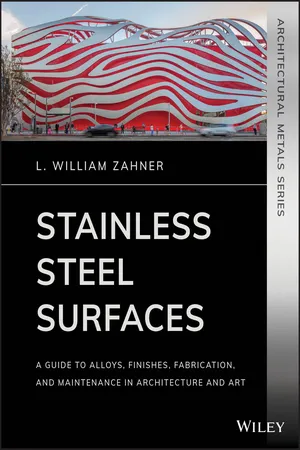
Stainless Steel Surfaces
A Guide to Alloys, Finishes, Fabrication and Maintenance in Architecture and Art
- English
- ePUB (mobile friendly)
- Available on iOS & Android
Stainless Steel Surfaces
A Guide to Alloys, Finishes, Fabrication and Maintenance in Architecture and Art
About this book
A full-color guide for architects and design professionals to the selection and application of stainless steel
Stainless Steel Surfaces offers an authoritative and comprehensive guide to the application of stainless steel to create surfaces for building exteriors, interiors, and art finishes. The first volume in Zahner's Architectural Metals Series, the book is a visual, full-color book filled with the information needed to ensure proper maintenance of stainless steel and suggestions for fabrication techniques. The author—a noted expert in the field—covers a range of topics including the history of the metal, choosing the right alloy, information on a variety of surface and chemical finishes, and facts on corrosion resistance.
Stainless Steel Surfaces is filled with illustrative case studies that offer strategies for designing and executing successful projects using stainless steel. All the books in the Zahner's Architectural Metals Series offer in-depth coverage of today's most commonly used metals in architecture and art. This important book:
• Contains a comprehensive guide to the use and maintenance of stainless steel surfaces in architecture and art
• Features full-color images of a range of stainless steel finishes, colors, textures, and forms
• Presents case studies with performance data that feature strategies on how to design and execute successful projects using stainless steel
• Offers methods to address corrosion, before and after it occurs
• Discusses the environmental impact of stainless steel from the creation process through application
• Explains the significance of the different alloys and the forms available to the designer
• Discusses what to expect when using stainless steel in various exposures
Architecture professionals, metal fabricators, developers, architecture students and instructors, designers, and artists working with metals, Stainless Steel Surfaces offers a logical framework for the selection and application of stainless steel in all aspects of architecture.
Frequently asked questions
- Essential is ideal for learners and professionals who enjoy exploring a wide range of subjects. Access the Essential Library with 800,000+ trusted titles and best-sellers across business, personal growth, and the humanities. Includes unlimited reading time and Standard Read Aloud voice.
- Complete: Perfect for advanced learners and researchers needing full, unrestricted access. Unlock 1.4M+ books across hundreds of subjects, including academic and specialized titles. The Complete Plan also includes advanced features like Premium Read Aloud and Research Assistant.
Please note we cannot support devices running on iOS 13 and Android 7 or earlier. Learn more about using the app.
Information
CHAPTER 1
Introduction to Stainless Steel
STAINLESS STEEL
Table of contents
- Cover
- Table of Contents
- Preface
- CHAPTER 1: Introduction to Stainless Steel
- CHAPTER 2: Alloys
- CHAPTER 3: Surface Finishes
- CHAPTER 4: Expectations of the Stainless Steel Surface
- CHAPTER 5: Designing with Available Forms
- CHAPTER 6: Fabrication Processes
- CHAPTER 7: Corrosion Resistance Characteristics
- CHAPTER 8: Maintaining the Stainless Steel Surface
- APPENDIX A: Stainless Steel Specifications Specific to Architectural and Art Applications (US and European)
- APPENDIX B: Relative Cost of Different Finishes of Wrought Stainless Steel
- APPENDIX C: Relative Gloss/Reflectivity of Different Stainless Steel Finishes
- APPENDIX D: List of Designers and Finishes Shown in the Book
- Index
- End User License Agreement